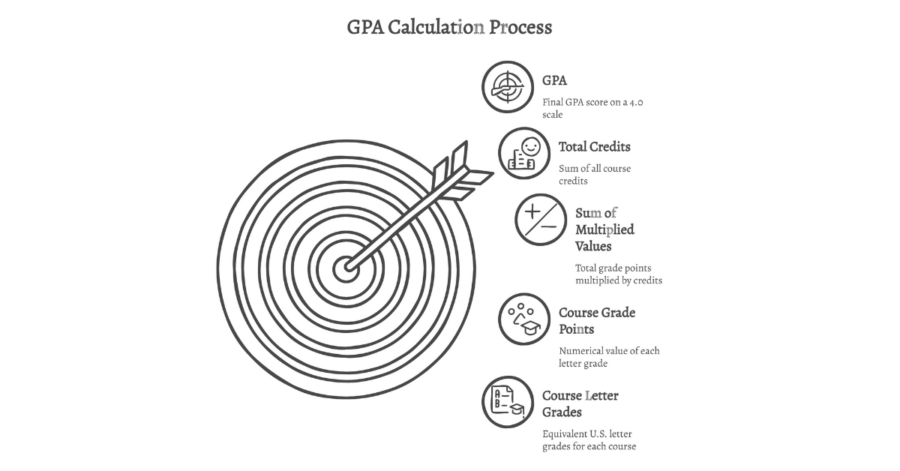8 May 2025
6 minutes read
How to Calculate GPA to a 4.0 Scale With a GPA Calculator (Convert and Calculate Your GPA as an Indian Student)?

Key Takeaways
- How to calculate GPA: Multiply each course’s grade point by its credit hours, sum the results, then divide by the total credits.
- How to calculate GPA: Use a GPA calculator to convert letter grades or percentages into the U.S. 4.0 scale efficiently.
- How to calculate GPA: Accurately align your academic scores with credit-weighted grade points for reliable cumulative results.
Not sure what your grade point average actually means when applying abroad? Let’s decode the mystery right here. If you’re an Indian student, your academic performance is often marked in percent or letter grades, while U.S. colleges expect a GPA on a 4.0 scale. But worry not—converting your GPA to 4.0 scale is much simpler than it sounds.
With the right GPA calculator, a basic understanding of credit, and this guide, you can quickly estimate, understand, and confidently submit your script. Let’s make that conversion crystal clear! Whether you’re an undergraduate applicant or preparing your master’s level thesis, this guide is a must.
How to Calculate Your GPA to a 4.0 Scale?
Fun fact: A perfect GPA of 4.0 in the U.S. equals straight A’s, or top-tier letter grades like 97–100%. Estimating your grades into the U.S. scale used for GPA is about matching your academic performance to their standard.

To calculate:
- Take each course and find the U.S. letter grade equivalent.
- Multiply each course’s grade points by the number of credits.
- Take the sum of these multiplied values.
- Divide the total by the total number of credits.
- Use a GPA calculator for a quicker GPA calculation.
This process helps estimate your GPA from a percent to a 4.0 GPA scale, just what many colleges and universities in the United States expect!
Cumulative GPA vs Semester GPA: What’s the Difference?
Understanding the difference between cumulative GPA and semester GPA is essential when preparing your script. While sem GPA reflects your performance in a single term, the cumulative grade point considers all your terms combined.
Schools often use both for internal tracking and external reporting. Some colleges even maintain separate GPAs for each.
| Feature | Sem | Cumulative |
|---|---|---|
| Based on | One semester | All semesters combined |
| Reflects | Short-term performance | Overall standing |
| Use case | Term-wise tracking | Graduation eligibility |
| Updates | Every term | Builds over time |
| GPA displays | Term GPA displays | GPA displays |
Average GPA: Calculation Methods and How to Convert Into Percentages
Fun fact: The average GPA across all U.S. high schools is about 3.1. That’s not bad, right? Understanding how this average works makes the process of GPA calculation a lot easier.
To find average GPA:
- Take the total of all your grade points.
- Divide by the number of classes.
- Use tenth place rounds for precision.
- Refer to your school’s grading scale.
- Confirm with the institution for exact GPA calculation.
| GPA | Range |
| 4.0 | 97–100 |
| 3.5 | 93–96 |
| 3.0 | 90–92 |
| 2.0 | 80–82 |
| 1.0 | 65–66 |
How to Convert Your GPA for U.S. Universities Using International Transcripts?
Fun fact: Even IB courses and secondary school internal records can be standardized to the U.S. GPA and use method! Most universities in the United States follow the common scale used: 4.0.

Here’s how to estimate it:
- Translate your grades to U.S. equivalents.
- Use official GPA calculator tools recommended by admissions.
- Match your percentage to the 4.0 grading scale.
- Consider weighted GPA if you took AP, honors, or IB levels.
- Double-check your result with the MIT registrar or colleges that report GPA. Since P grades can affect the GPA, it’s essential to clarify those.
This is crucial for any student planning to submit their academic transcript for admission to American universities, especially those eyeing first-year students intakes.
Pro Tip: Don’t forget to prep for tests like ACT, IELTS, TOEFL, GRE, SAT, and GMAT—since many colleges evaluate your GPA along with those.
Where to Find Related Articles and Resources on GPA and Grade Systems?
Fun fact: Many international students often search for related articles only to end up overwhelmed. Don’t worry, we’ve simplified it here.
Look here:
- Official U.S. colleges report GPA websites.
- MIT grade point average standards.
- Blogs explaining GPA and use across regions.
- Forums discussing overall GPA concerns.
- Resources comparing internal record vs external record grading.
| Source Type | Details |
| University Sites | Offer exact GPA conversion steps |
| Calculators | Tools like GPA calculator |
| Forums | Peer advice on grades & admission |
| Guides | Explain divide the sum rules |
| Articles | Cover topics like 5.0 GPAs |
Conclusion
Whether you’re calculating your sem GPA, checking your GPA, or trying to estimate your GPA to 4.0 scale, the process becomes easier when you know the exact method. From credit values and grade points to understanding how cumulative GPA displays on your report, everything fits together like a puzzle.
This guide walked through key differences between cumulative and sem GPA, the math behind average GPA calculation, how to turn into percentages, and resources for deeper insight. We also touched on systems used by top schools and references like MIT grade point, and how tools like GPA calculator help you count with ease.
Go ahead, decode your script with clarity—your dream college awaits!
FAQs
How to calculate GPA from percentage as an Indian student?
To understand how to calculate GPA from percentage, match your scores to U.S. letter grade equivalents and apply the 4.0 scale.
How to calculate GPA on a 4.0 scale?
To know how to calculate GPA on a 4.0 scale, convert each grade to grade points, multiply by credit hours, and divide the total by credits attempted.
How to calculate GPA if my college uses CGPA?
If you’re wondering how to calculate GPA from CGPA, multiply your CGPA by a conversion factor like 0.95 or refer to the university’s scale guidelines.
How to calculate GPA with different credit hours?
Knowing how to calculate GPA when credit hours vary means using a weighted average: multiply each grade point by its credit, then divide by total credits.
How to calculate GPA without a GPA calculator?
To understand how to calculate GPA manually, convert each grade into a point value, perform the weighted average, and ensure all credits are included.
How to calculate GPA with backlogs or retakes?
If you’re unsure how to calculate GPA after retakes, check if the latest grade replaces the old one or if both are counted—policies vary by institution.
How to calculate GPA for U.S. university applications?
When learning how to calculate GPA for U.S. applications, use standardized tools, official scales, and match your transcripts to their academic format.

You can study at top universities worldwide!
Get expert tips and tricks to get into top universities with a free expert session.
Book Your Free 30-Minute Session Now! Book a call now




























